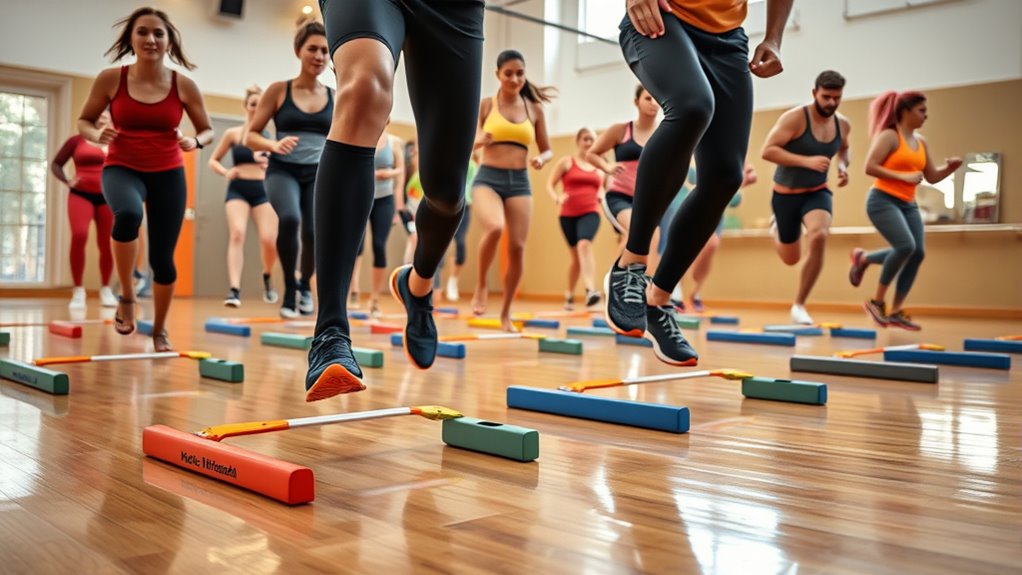Agility ladder drills are perfect for all fitness levels, helping you improve coordination, speed, and agility with simple steps. Start slow with basic two-foot hops or lateral shuffles, then modify drills as you progress. Focus on proper form, keep light on your feet, and incorporate support if needed. As you advance, challenge yourself with faster and more complex patterns. Keep practicing steadily, and you’ll discover new ways to boost your performance—there’s more to explore here.
Key Takeaways
- Start with basic two-foot hops focusing on rhythm and soft landings to build confidence for all fitness levels.
- Gradually increase speed and complexity, incorporating lateral shuffles and quick taps as skill improves.
- Use support techniques like wall holds or partner assistance to ensure safety and stability during drills.
- Incorporate creative variations, such as obstacle courses or plyometric moves, to keep workouts engaging and challenging.
- Track progress by timing drills and setting achievable goals to enhance motivation and measure improvement.
Getting Started With Basic Ladder Steps

To begin with, mastering basic ladder steps is essential for building agility and coordination. Focus on proper foot placement; keep your feet light and quick as you step inside and outside the ladder. Start with simple two-foot hops, landing softly on the balls of your feet, which helps improve balance and control. Rhythm training is vital here—sync your movements with a steady beat to develop consistency. Count your steps or match them to a metronome to establish a smooth, rhythmic pattern. Keep your upper body relaxed, arms at your sides, and stay centered. As you become more comfortable, increase speed gradually while maintaining precise foot placement and rhythm. This foundation will set you up for more advanced ladder drills and better overall agility. Incorporating celebrity transformations and their resilience stories can motivate you to push through challenging drills and improve your performance. Additionally, understanding the importance of proper equipment, such as quality ladders and supportive footwear, can enhance safety and effectiveness during training. Developing muscle memory through consistent practice will help you perform the drills more effortlessly over time. Furthermore, integrating training technology like apps and video tutorials can offer valuable guidance and track your progress.
Modifying Drills for Beginners

As a beginner, start by slowing down your movements to build confidence and coordination. Don’t hesitate to ask for support or guidance from a trainer or teammate to stay on track. Adjusting your speed and seeking help makes the drills more manageable and helps you progress safely. Incorporating proper exfoliation techniques can also support your overall fitness journey by promoting healthier skin. Additionally, choosing a suitable hybrid bike can enhance your comfort and confidence as you develop your skills. Being mindful of fitness safety tips can further prevent injuries and enhance your training effectiveness. Understanding city dynamics and local resources can help you navigate your new environment more smoothly as you progress.
Adjusting Speed for Beginners
Starting with a slower pace can help beginners build confidence and master proper technique before increasing speed. Adjusting your speed allows for better control and reduces the risk of mistakes. Focus on maintaining steady, deliberate steps as you set your beginner pacing. As you become more comfortable, gradually increase your speed to challenge yourself without sacrificing form. Use the following table to visualize different speed levels: user privacy. Incorporating a training progression approach ensures steady improvement and minimizes setbacks. Monitoring your performance metrics can help you identify when you’re ready to advance to faster drills. Remember that proper technique is essential at all skill levels to prevent injury and promote effective training.
Using Support and Guidance
Using support and guidance can make beginner-friendly ladder drills more manageable by providing stability and direction. Support techniques, such as holding onto a wall or using a partner for balance, help you stay steady as you learn the movements. Guidance strategies, like demonstrating proper foot placement and offering verbal cues, assure you understand each step. Start with simple modifications, like slow step-throughs or reduced repetitions, to build confidence. Encourage yourself with positive feedback and adjust the drill’s intensity as needed. These support techniques and guidance strategies make it easier to focus on proper form and coordination. Additionally, understanding basic training principles can help tailor the drills to your fitness level and prevent injury. Using support wisely can also help you develop correct technique more effectively and safely. Incorporating adaptive methods, such as adjustable support tools, can further enhance your learning process. Recognizing the importance of emotional resilience can motivate you to stay committed during challenging practice sessions. Over time, you’ll develop the skills and confidence to perform more advanced drills independently. Using support wisely accelerates your progress and keeps your training safe and effective.
Intermediate Ladder Challenges to Boost Speed

To take your agility ladder skills to the next level, incorporating intermediate challenges can substantially boost your speed and coordination. Focus on foot speed by trying quick, alternating foot taps within each box, pushing yourself to move faster without losing control. Coordination drills, like two-foot-in, two-foot-out patterns, help improve your timing and balance. Another effective challenge is lateral shuffles, where you move side to side across the ladder, enhancing your ability to change directions swiftly. These drills demand focus and precision, forcing you to synchronize your movements efficiently. Consistently practicing these intermediate ladder challenges will sharpen your foot speed and coordination, laying a solid foundation for more advanced agility work and helping you perform better in sports and fitness activities. Incorporating agility training into your routine can also improve your overall athletic performance and reaction time. Understanding tuning techniques used in vehicle performance can also inspire you to fine-tune your training for optimal results. Furthermore, paying attention to training variability ensures your workouts remain effective and engaging.
Advanced Techniques for Explosive Power

Unlocking explosive power requires mastering advanced techniques that maximize your strength and speed. To push your limits, focus on exercises that boost speed endurance and enhance coordination. These techniques help you generate quick, powerful movements that translate into real-world athletic performance. By integrating plyometric jumps, single-leg hops, and rapid foot strikes, you challenge your body to produce maximum force in minimal time. Regular practice refines your neuromuscular connection, leading to better coordination enhancement. As your explosive power grows, you’ll notice improvements in your overall agility and athletic ability. Keep pushing your boundaries with these advanced methods to unleash your full potential. Understanding the fundamentals of explosive training ensures you apply techniques safely and effectively. Additionally, paying attention to proper application timing can optimize the effectiveness of each drill, ensuring your body is prepared for explosive movements. Incorporating proper tuning of your training regimen helps prevent injury and enhances performance gains over time. Moreover, understanding the importance of financial aspects in training planning can help you allocate resources efficiently for equipment and coaching.
Incorporating Ladder Drills Into Your Workout Routine

Incorporating ladder drills into your workout routine is a highly effective way to enhance agility, coordination, and speed. To maximize benefits, consider your nutrition tips by fueling your body with proper carbs and proteins to support energy and recovery. Include ladder drills in your warm-up to boost performance and prepare your muscles, which also aids injury prevention. Start with basic steps and gradually increase intensity to avoid overexertion. Consistency is key—integrate these drills 2-3 times a week for noticeable progress. Remember, building strength and endurance alongside ladder work enhances overall fitness. Proper hydration and balanced meals will keep you energized and help prevent injuries. With dedication and mindful nutrition, ladder drills become a safe and effective addition to your fitness journey. Proper planning of RMDs can also help you manage your retirement goals alongside your workout routine.
Tips for Proper Form and Safety

Ensuring proper form and safety during ladder drills is essential to prevent injuries and maximize effectiveness. Focus on precise foot placement to maintain balance and agility, avoiding sloppy movements that could cause strain. Keep your core engaged and stay light on your toes, allowing quick, controlled steps. Use proper breathing techniques—inhale deeply through your nose and exhale steadily—to stay calm and energized. Always start slow to master your technique before increasing speed. Remember, safety comes first, so listen to your body and avoid overexertion.
- Feel confident with every step, knowing you’re building strength safely
- Maintain focus to avoid missteps and potential injuries
- Embrace controlled movements that boost your confidence
- Prioritize your well-being over speed
- Celebrate progress, no matter how small
Creative Variations to Keep Things Fun

To keep agility ladder drills exciting, try adding plyometric moves like jump squats or box jumps to boost power. You can also incorporate light resistance bands to increase the challenge or set up obstacle challenges that test your agility and coordination. Mixing these variations keeps your workouts fresh and pushes your limits in a fun way.
Incorporate Plyometric Moves
Adding plyometric moves to your agility ladder drills can boost both power and speed while keeping your workout exciting. Plyometric training focuses on explosive movements that enhance your athletic performance. By incorporating jumps like lateral bounds, box jumps, or tuck jumps into your routine, you challenge your muscles and improve coordination. These dynamic exercises make your drills more engaging and effective.
Feel the rush of your muscles firing, experience the thrill of quick landings, and notice your strength growing. Plyometric training not only elevates your agility but also energizes your entire workout. Keep pushing your limits with these explosive variations, and watch your fitness level soar.
- Experience adrenaline with each explosive jump
- Feel unstoppable as your power increases
- Transform your workout into a fun, high-energy challenge
- Activate your true athletic potential
- Enjoy every moment of your progress
Use Light Resistance Bands
Incorporating light resistance bands into your agility ladder drills introduces a new challenge that boosts strength and coordination while keeping your routine fresh. Using band resistance adds an extra layer to agility training by engaging your muscles more actively during quick footwork. Attach the bands to your ankles or legs to increase the difficulty of ladder patterns, forcing your muscles to stabilize and work harder. This variation not only improves balance but also enhances overall power and speed. Keep movements controlled to maximize band resistance benefits without sacrificing form. By blending resistance bands into your drills, you challenge your body differently, making agility training more dynamic and engaging. These creative variations help you build strength and agility simultaneously, keeping your workouts effective and fun.
Add Obstacle Challenges
Introducing obstacle challenges into your agility ladder drills can turn a standard workout into a fun, dynamic experience that tests your coordination and problem-solving skills. By adding obstacles, you create opportunities for balance challenges and enhance your coordination drills. These variations keep your mind engaged and push your limits, making workouts feel fresh and exciting.
Try incorporating items like cones, hurdles, or ropes to navigate around or over. You could also set up different textures or shapes for added sensory input. The key is to challenge yourself while maintaining control and precision. These obstacle challenges not only boost your agility but also build mental resilience and confidence.
- Feel the thrill of conquering new obstacles
- Improve your focus and reaction time
- Experience the joy of overcoming physical barriers
- Elevate your training with creative twists
- Keep workouts engaging and fun
Tracking Progress and Setting Goals

Tracking your progress and setting clear goals are essential steps to improve your agility ladder drills. Progress tracking allows you to see how much you’ve improved over time, helping you stay motivated and focused. Use a journal or digital app to record your times, repetitions, and overall performance during each session. Goal setting gives you specific targets to aim for, whether it’s increasing speed, reducing mistakes, or completing more complex drills. Break larger objectives into smaller, achievable milestones to maintain momentum. Regularly review your progress to identify areas for improvement and adjust your goals accordingly. By actively tracking progress and setting realistic, measurable goals, you’ll stay committed and make steady progress toward mastering agility ladder drills.
Frequently Asked Questions
Can Ladder Drills Improve My Overall Athletic Performance?
Yes, ladder drills can boost your overall athletic performance by enhancing your speed agility and cardiovascular endurance. As you practice quick, precise footwork, you develop better coordination and reaction times. This translates to improved performance in sports and daily activities. Plus, the cardio aspect helps build stamina. Incorporating ladder drills into your routine keeps workouts dynamic and effective, helping you become faster, more agile, and more resilient overall.
How Often Should I Incorporate Ladder Drills Into My Workouts?
Think of your workout routine as a garden that needs regular watering. To see healthy growth, you should incorporate ladder drills into your training frequency about 2-3 times a week. This allows your muscles to adapt and improve without overwatering. Integrate these drills smoothly into your workouts, balancing agility and recovery, so your performance blossoms naturally over time. Consistency is key to reaping the full benefits.
Are Ladder Drills Suitable for Injury Rehabilitation?
Ladder drills can be useful during injury recovery if your healthcare provider approves. They serve as rehabilitation exercises to improve coordination, balance, and agility, but you should start slowly and avoid high-impact moves. Always consult your doctor or physical therapist before incorporating ladder drills into your injury rehabilitation plan. Proper guidance guarantees you use these drills safely, supporting your recovery without risking further injury.
What Equipment Is Needed Besides the Ladder Itself?
Sure, because who wouldn’t want to add more equipment options to their workout? Besides the ladder, you might need a timer or markings to measure distance, and comfortable athletic shoes for safety considerations. You don’t need much—just enough to keep your session effective and safe. Remember, the right footwear and clear space are key safety considerations, making sure you avoid injuries and maximize your agility training.
How Do I Prevent Common Mistakes During Ladder Exercises?
To prevent common mistakes during ladder exercises, focus on maintaining proper form and start with beginner tips. Keep your feet quick and light, avoiding overstriding or rushing through steps. Stay low and controlled, engaging your core. Watch your timing and guarantee you’re not hesitating or bouncing excessively. Practicing these habits helps improve coordination and reduces injury risk, making your workout safer and more effective.
Conclusion
As you weave through the tapestry of agility ladder drills, each step becomes a brushstroke in your fitness masterpiece. Embrace the journey, fueling your progress like a steady river carving new pathways. With dedication and creativity, you’ll turn every session into a symphony of movement, revealing strength and speed that ripple beyond the ladder. Keep pushing forward—your evolving agility is the compass guiding you toward a stronger, more explosive you.










